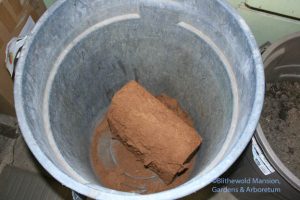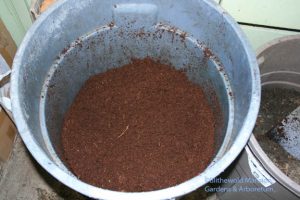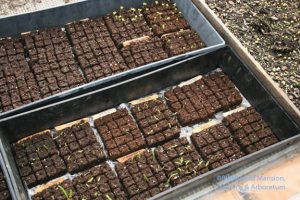On the coir bandwagon
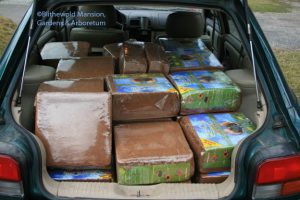 When Fred (Blithewold’s dir. of hort.) suggested that Gail and I start making our own potting soil, we were totally game. We had already started looking into alternatives to our peat based mixes and were interested in trying out this coir stuff that everyone is talking about. Coir (rhymes with foyer) is a coconut industry byproduct – when coconuts are harvested for the meat and milk the fiber (the coir) from the shells is used for all sorts of other things – like rope, doormats, the pots we’re now using instead of peat pots – and the coir dust makes an excellent soil amendment. It’s on the slightly acidic side of pH neutral, has high water retention and slow release; it’s re-wettable, and biodegradable. It’s also an easily and sustainably renewable resource. Peat moss, on the other hand, grows back at a rate of 1-2 millimeters per year and must be very carefully harvested in order to remain at all sustainable. And the amazing thing about peat bogs is that peat absorbs carbon dioxide and as it’s held in the earth, the bogs act as global coolers. When the bogs are disturbed however, the gas is released which, as you know, contributes to global warming. (Very uncool.)
When Fred (Blithewold’s dir. of hort.) suggested that Gail and I start making our own potting soil, we were totally game. We had already started looking into alternatives to our peat based mixes and were interested in trying out this coir stuff that everyone is talking about. Coir (rhymes with foyer) is a coconut industry byproduct – when coconuts are harvested for the meat and milk the fiber (the coir) from the shells is used for all sorts of other things – like rope, doormats, the pots we’re now using instead of peat pots – and the coir dust makes an excellent soil amendment. It’s on the slightly acidic side of pH neutral, has high water retention and slow release; it’s re-wettable, and biodegradable. It’s also an easily and sustainably renewable resource. Peat moss, on the other hand, grows back at a rate of 1-2 millimeters per year and must be very carefully harvested in order to remain at all sustainable. And the amazing thing about peat bogs is that peat absorbs carbon dioxide and as it’s held in the earth, the bogs act as global coolers. When the bogs are disturbed however, the gas is released which, as you know, contributes to global warming. (Very uncool.)
Personally, I’d rather leave the bogs alone but peat moss has forever been every gardener’s go-to soil amendment. In terms of feeding the soil though, there are much better alternatives – like shredded leaves, mushroom compost, and everyday garden compost – all three of which add nutrients while improving the texture, aeration, and water retention. Coir is more like peat – it’s a nutrient sponge that retains and releases whatever is added to it. Its water holding capacity and re-wet-ability make it an ideal potting mix ingredient. (Potting mixes need to be Goldilocks-perfect: Not too heavy, too light, too wet, or too dry – but juuuussst right.)
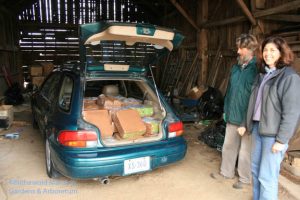 The great people at The Good Earth in Hope, RI offered to share a pallet of Fibre Dust, LLC Coco-Coir bales with us – none of us needed all 990 odd pounds – so Gail and I packed my little car with a third of the pallet which should keep us going for a while. One 12″x12″x5″ tightly packed bale puffs up to 2.2 – 2.5 cubic feet or about two thirds of a 32 gallon container.
The great people at The Good Earth in Hope, RI offered to share a pallet of Fibre Dust, LLC Coco-Coir bales with us – none of us needed all 990 odd pounds – so Gail and I packed my little car with a third of the pallet which should keep us going for a while. One 12″x12″x5″ tightly packed bale puffs up to 2.2 – 2.5 cubic feet or about two thirds of a 32 gallon container.
For potting up transplants right now, we’ll add it to the potting mixes we already have on hand. As we start work on potting up the container bed, we’ll mix it with screened compost. And next year when we sow seeds we might consider trying soil blocks like the ones the Holschers make at The Good Earth – we could reduce our reliance on peat packs and then be very nearly, almost entirely peat free.
Have you used any coir based potting mixes? (Do you make your own?) What do you think of it?

